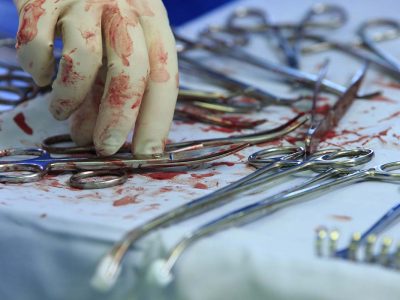Question:
The article in the March 2017 Patton newsletter titled, “More Sophistication Mandated in High-level Disinfection & Sterilization” regarding the need to use a rigid container with a bio-hazard label to transport from the bedside to soiled utility room has thrown us here at our hospital into a frenzy. Aside from needing to purchase rigid containers for bedside use, the questions then arise where are they stored, who cleans them between use, and other operational questions. From your travels can you tell me how other facilities are managing this issue?
Answer:
You are in good company. A safe and effective process we are now seeing regularly is that rigid plastic boxes or bins with covers are purchased in the sizes needed for the various locations. These may be molded in red plastic, or have a red lid, or be clear but have some means of affixing a tag or label to denote that the contents are (ultimately going to be) bio-hazardous. In an ICU or ED you might need small bins the size of large pencil case or shoe box, whereas large-use departments or areas with larger equipment may need larger sizes. Once purchased and cleaned, these then are stored in a clean location, such as a clean utility room. Prior to conducting a bedside procedure staff would pick up a clean bin from the clean utility room and have it ready along with other supplies at bedside. The procedure is performed, the instruments are pre-cleaned at bedside per the AAMI ST79 guideline, placed in the bin, covered with the lid, labeled as bio-hazardous, gloves are doffed, hand are washed or sanitized, and the bin is transported to the nearest soiled utility room. There, again wearing fresh, appropriate PPE, staff spray down the instrument in the bin with an hospital-approved wetting agent to keep the instrument moist while it awaits SPD staff arrival to pick up the bin and bring it to SPD for processing. SPD sterilizes the equipment and will also cleans the bin. The cleaning of the bin can be as simple as wiping down with an appropriate low level disinfectant wipe (again, following the manufacturer IFU and AAMI guidelines) BUT some SPDs choose to send these through the washer/sanitizer in SPD. Once clean and dry, these clean bins are returned to the units from which they came.
It takes a lot of conversation to figure out how this will work in each location. Each location has different work flow, different volume, different transport time to SPD and often different nuances that may require unique solutions to fit each location. We also see disposable trays or bins (rigid, covered, labeled as biohazardous) used to carry instruments. This may first appear costly on a per-use basis, but should really be considered as it may prove cheaper than having SPD clean and transport bins back and forth to the units. Finally, depending on the instrument being transported (e.g., an TEE probe) some areas may be able to use disposable plastic, puncture resistant bags for the transport of contaminated equipment to SPD. Again, consult AAMI ST79 (section 6.4) and incorporate the guideline into your written standard operating procedure.
We see some hospitals transport the plastic bin from a bedside procedure to a soiled utility room and then move the contaminated instrument from the “carry” bin to a larger SPD bin that is picked up by SPD. In this model you have unit staff clean the “carry” bin with proper wipes and return them to a clean area on the unit. For various reasons, this may be a more risk-prone solution. You have additional staff exposure to the instrument in soiled utility along with the risk of splashing contaminated fluid around the room, and you have nurses or other care givers low-level disinfecting the plastic bin; thus this is not our preferred solution.


 Focus on Infection Control and Hazardous Medications
Focus on Infection Control and Hazardous Medications
Leave a Reply